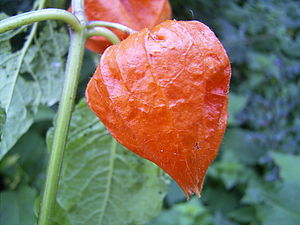Note: This is a project under development. The articles on this wiki are just being initiated and broadly incomplete. You can Help creating new pages.
Physalis alkekengi - Bladder cherry
Physalis alkekengi (bladder cherry, Chinese lantern, Japanese-lantern, strawberry groundcherry, or winter cherry) is a relative of P. peruviana (Cape gooseberry). It is easily identifiable by the large, bright orange to red papery covering over its fruit, which resembles paper lanterns.
Contents
Uses
Tentex forte, Muscle & Joint Rub, Impotency & Erectile dysfunction, Diarrhoea, Pharyngitis & Sore Throat, Toothache, Pyorrhea, Common Cold, Childhood apraxia of speech, Delayed Speech Development.
Parts Used
Chemical Composition
Like a number of other species in the genus Physalis, it contains a wide variety of physalins. When isolated from the plant, these have antibacterial and leishmanicidal activities in vitro.It also contains caffeic acid ethyl ester, dehydro-physalin L, physalin D, and cuneataside E[1]
Common names
| Language | Common name |
|---|---|
| Kannada | |
| Hindi | Akarkara |
| Malayalam | Akkarakaaram |
| Tamil | |
| Telugu | |
| Marathi | NA |
| Gujarathi | NA |
| Punjabi | NA |
| Kashmiri | NA |
| Sanskrit | Akarkarabh |
| English | Pellitory |
Habit
Identification
Leaf
| Kind | Shape | Feature |
|---|---|---|
| Smooth | Alternate, Pinnate | The leaves are with deeply-cut segments |
.[2]
Flower
| Type | Size | Color and composition | Stamen | More information |
|---|---|---|---|---|
| Unisexual | 14-18cm long | Yellow, Circular | Each bears one large flower the disk being yellow and the rays white, tinged with purple beneath. |
Fruit
| Type | Size | Mass | Appearance | Seeds | More information |
|---|---|---|---|---|---|
| Syncarp (sorosis), subglobose or ellipsoid with long echinate processes, orange when ripe | seeds many, ovoid. | {{{6}}} |
Other features
List of Ayurvedic medicine in which the herb is used
- Vishatinduka Taila as root juice extract
Where to get the saplings
Mode of Propagation
How to plant/cultivate
It is a popular ornamental plant, though it can be invasive with its wide-spreading root system sending up new shoots some distance from where it was originally planted. In various places around the world, it has escaped from cultivation[3]
Commonly seen growing in areas
wasteland, gardens, Ornamental.
Photo Gallery
References
External Links
- Ayurvedic Herbs known to be helpful to treat Tentex forte
- Ayurvedic Herbs known to be helpful to treat Muscle & Joint Rub
- Ayurvedic Herbs known to be helpful to treat Impotency & Erectile dysfunction
- Ayurvedic Herbs known to be helpful to treat Diarrhoea
- Ayurvedic Herbs known to be helpful to treat Pharyngitis & Sore Throat
- Ayurvedic Herbs known to be helpful to treat Toothache
- Ayurvedic Herbs known to be helpful to treat Pyorrhea
- Ayurvedic Herbs known to be helpful to treat Common Cold
- Ayurvedic Herbs known to be helpful to treat Childhood apraxia of speech
- Ayurvedic Herbs known to be helpful to treat Delayed Speech Development
- Herbs with Dried Roots used in medicine
- Herbs with Leaves used in medicine
- Herbs with Flower used in medicine
- Herbs with common name in Hindi
- Herbs with common name in Malayalam
- Herbs with common name in Sanskrit
- Herbs with common name in English
- Habit - Perennial herb
- Index of Plants which can be propagated by Seeds
- Index of Plants which can be propagated by Cuttings
- Herbs that are commonly seen in the region of wasteland
- Herbs that are commonly seen in the region of gardens
- Herbs that are commonly seen in the region of Ornamental
- Herbs



